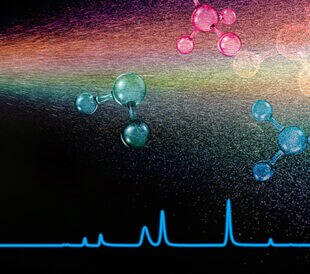Polysorbates (PS) are amphiphilic non-ionic surfactants used as emulsifiers, stabilizers and solubilizers in pharmaceutical and biopharmaceutical formulations, foods and even cosmetics.
 Accurate measurement of PS is essential for the quality and safety of products. The problem is, most commercially available PS materials are complex heterogenous mixtures of hundreds of molecules, including low-level components such as impurities and degradants.
Accurate measurement of PS is essential for the quality and safety of products. The problem is, most commercially available PS materials are complex heterogenous mixtures of hundreds of molecules, including low-level components such as impurities and degradants.
Two analytical approaches for measuring PS by HPLC analysis are typically used: a single peak method for quantitation, and a profiling method capable of measuring and quantifying many components to determine quality.
Published methods around these two approaches differ, with one variation tied to the type of detector. Common methods use mass spectrometry, charged aerosol detection (CAD), or evaporative light scattering detection (ELSD).
This blog explores the chemistry behind why PS compounds are complex, compares the single peak and profiling methods, and highlights why CAD is superior to ELSD for PS analysis.
The chemistry behind why polysorbate compositions are complex and variable
 Characterizing the purity, stability and degradation products of PS compounds in a complex mixture often presents analytical challenges for a few reasons: (I) the starting materials are impure mixtures, (II) PS is prone to degradation, and (III) PS in the final product is present at only around 20% of the expected structure.
Characterizing the purity, stability and degradation products of PS compounds in a complex mixture often presents analytical challenges for a few reasons: (I) the starting materials are impure mixtures, (II) PS is prone to degradation, and (III) PS in the final product is present at only around 20% of the expected structure.
Variations in chemical profiles can occur from lot-to-lot due to inconsistency of the synthetic process and may influence the behavior of PS in liquid formulations.
These differences can affect the solubility of free fatty acids impurities, leading to the formation of unwanted particulates in the final product.
Regulatory requirements defined by the European Pharmacopeia and US Pharmacopeia 790 are strict regarding the presence of particles in injectable drugs, as they are generally supposed to be “essentially/practically free of visible particles.”
And particle formation in injectables is one of the leading causes of recalls.
Let’s take a deeper dive into the synthetic route
Polysorbates are produced by the esterification of polyoxyethylene sorbitan with a fatty acid.
The different types of PS compounds – like polysorbate 20 (PS20) and polysorbate 80 (PS80) – are defined by the chain length of the parent acid.
- PS20 comes from lauric acid
- PS80 comes from oleic acid
The starting materials originate from naturally impure sources and contain numerous impurities such as other esterifiable fats, which is every chemist’s nightmare. For example, oleic acid is often contaminated with other fatty acids like palmitic, linoleic and stearic.
Variations in chemical profiles can occur from lot-to-lot and may influence the behavior of PS in biotherapeutic formulations. These differences can affect the solubility of free fatty acids impurities, leading to the formation of unwanted particulates in the final product.
The additional presence of the precursor and side product of sorbitan, sorbitol and isosorbide, along with different degrees of ethoxylation of the main and byproducts, can result in a mixture of >1,500 components.
So, do you see how the production of PS gets messy, quickly?
That’s not including the degradation products, either!

Synthesis of PS80 showing mixture of POE products. Figure modified from: Li et al., Anal. Chem., 2014, 86, 5150-5157.
What we know about the degradation of polysorbates in solution
Studies show PS degrade by autooxidation and hydrolysis pathways:
- Autooxidation of PS tends to occur on the polyoxyethylene (POE) side via the formation chain propagating peroxides and leads to the formation of ketones, aldehydes, and peroxides
- Light, heat and redox active metals like copper and iron trigger oxidative degradation processes
- Hydrolysis of PS happens by cleavage of the ester bond and yields free fatty acids that are prone to precipitation, plus oxidatively modified POE compounds
- Increasing heat and pH can accelerate cleavage reactions
So, thinking forward to product development, you most certainly need a dependable analytical method to separate and identify the complex mixture of PS components that come from synthetic and degradation pathways.
Established methods for quantifying and profiling polysorbates by HPLC analysis
Quantification and profiling are two ways you can analyze PS in solution, but your results depend on the type of detection method and workflow.
- The single-peak method for quantifying PS involves the elution of all chemical components with a single column and detector. Established procedures use HPLC-CAD or HPLC-ELSD analysis.
- Advanced methods include profiling and quantification for characterizing individual components in formulations, which is a must-do for any injectable formulations. Profiling methods may include a single column and detector or more advanced 2D-LC approaches.
Here’s a breakdown of some common published methods:
| Method | Single peak
quantification |
Profiling without
quantification |
Profiling with
Quantification |
Formulation
analysis |
| Analytical
workflow |
Single column &
Single detector |
Single column &
Single detector |
Single column &
Single detector |
Two columns &
Multi-detector |
| Benefits | Measures total concentration of PS in solution and can’t tell apart different esters | Provides fingerprint ofPS subspecies and possible degradation pathways | Shows what PS compounds and fatty acid chains are present and the abundance | Gives insight on behavior of PS species in real-time stability samples |
| Considerations | Good sensitivity but also measures interferences leading to overestimation | Shows differences in abundance of the PS esters across production batches | May reveal the quality of raw materials and assess lot-to-lot variability | Requires removal of protein interferences using off-line or on-line workflows |
| Reference | Development and Validation of a Polysorbate 20 Assay in a Therapeutic Antibody Formulation by RP-HPL… | Characterization of Polysorbate 80 by Liquid Chromatography-Mass Spectrometry to Understand Its Susc… | Polysorbate 80 profiling by HPLC with mass and charged aerosol detection | Characterization and Stability Study of Polysorbate 20 in Therapeutic Monoclonal Antibody Formulatio… |
Why is CAD better than ELSD for characterizing polysorbates?

When attempting to quantify a compound, liquid chromatographers typically turn to HPLC-UV methods. While this approach may work well for compounds that contain a chromophore, it is of little use when compounds don’t have light-absorbing structures.
Because most PS lack a chromophore, you need to use a different analytical approach for quantification like CAD or ESLD.
But which is the best detector, CAD or ELSD?
CAD is more sensitive than ESLD and less impacted by the optical properties of the analyte. CAD also has a better uniform response essential for standard free quantitation, wider dynamic range, less complex calibration curves, and is easier to use.
Take your polysorbate analysis a step beyond with Charged Aerosol Detection
I hope this information reviewed in this blog will help guide you on how improve your future PS analysis.
No matter which workflow you choose – single dimension or multi-dimensional — you should most certainly opt for Charged Aerosol Detection to get the most out of your analysis in a single run.
Time is your most valuable asset in life, so why not set yourself up for success from the start?

How to Get More Accurate HPLC Quantitation of Semi-Volatiles
Struggling to accurately measure semi-volatile analytes? Str...
Read More
Episode 3: Understanding How Charged Aerosol Detection (CAD) Works
Welcome back to our series on Charged Aerosol Detection (CAD...
Read More
Episode 2: The Benefits of CAD Compared to Other Universal Detectors: ELSD and MALS
Welcome back to our series on Charged Aerosol Detection (CAD...
Read More
Episode 1: The Benefits of Charged Aerosol Detection (CAD) in High-Performance Liquid Chromatography (HPLC)
High-Performance Liquid Chromatography (HPLC) is a cornersto...
Read More